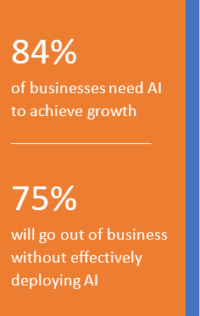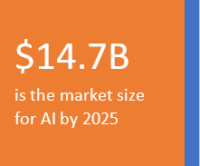Introduction
Nearly 84 percent of C-suites say they will need artificial intelligence (AI) to achieve their growth objectives, according to a recent report published by the consulting firm Accenture – which surveyed 1,500 executives across 16 industries. In the same report, 75 percent of executives said they expect to go out of business within the next five years if they do not deploy AI effectively.
If one thing has become clear, it’s that AI is no longer a luxury. It’s a necessity in today’s evolving business environment.
As a small refresher, AI is an advanced form of analytics that relies on the availability of large quantities of data. The technology uses this data as well as past events to predict future outcomes. Part of the reason AI has become such a buzz word as of late is because of the increase in tangible data — 90 percent of the world’s data was created in the last decade alone and increasing exponentially. The challenge now is to keep up with the data and analyzing it fast.
AI is helping businesses become more competitive and reinventing the way they do business. With all of that said, just injecting AI into your company will not guarantee success. It requires a fundamental shift in a company’s technology, business model, and culture.
While AI continues to march into the business world and the everyday lives of consumers, here are some trends to keep an eye on this year.
The Democratization of AI
Once upon a time, AI was a phrase used exclusively by startup founders and bigwig investors. Now, that is no longer the case. As enterprise leaders realize they need AI to survive, the technology is becoming mainstream and making its way into departments and businesses of all sizes.
Personalized Services
It is no coincidence that products like Alexa and Google Home are now in tens of millions of homes. Expect to see many of the AI services deployed aimed at delivering a personal touch. Personal assistants will become more proactive as they learn our habits and adapt to our behaviors. They will rely on that information to offer customized and additional services. For example, many banks now have chatbots to provide customers assistance for simple transactions and automated appointment scheduling. The use of speech to interact with the customer allows for a smoother all-around operation.
Process Automation
Businesses are always looking for ways to bolster employee productivity and increase overall efficiency. With AI, almost all businesses will be able to automate time-consuming, manual, and mundane tasks. For example, nearly all human resources departments are forced to spend copious amounts of time reviewing stacks of resumes and recommending candidates. That’s just one task that AI could execute in a much more efficient and accurate manner, with minimal or no human interaction at all. Or think about all the documents a law firm must analyze to find similarities between different cases. The potential uses of AI are virtually endless.
Privacy, Security and Ethics
The driving force behind AI is data. But where did that data come from? And how can it be used? Who should be allowed to access this data? Those are just some of the questions related to privacy, security, and ethical issues that will need to be addressed. Regulations like the General Data Protection Regulation (GDPR) in Europe are necessary. There will need to be procedures and controls in place for how the data is stored, processed, and ultimately provided to the user. It is essential to ensure that data is protected and doesn’t get in the wrong hands, and therefore imperative that security and data protection plays an important part in the strategy moving forward.
Edge Computing
Massive amounts of data are generated from many different sources, such as camera feeds and autonomous cars. The challenge is how to deliver that data to a place close to where it is derived so that it can be analyzed without delay. Moving all the data over a network is not practical and certainly not scalable. That’s why Edge Computing is essential to AI. Edge Computing provides data storage and processing capabilities in the proximity or part of the device or sensor that created the data. Edge Computing can be a powerful solution combined with public clouds.
Robotics
As you may have heard, Amazon is already contemplating using drone robots to help deliver its daily hoard of packages to customers. But so far, the use of most robots has been limited to the enterprise, agriculture, and military sectors. AI will increase the use of robots outside of traditional areas. Robots will need features like speech recognition and text-to-speech, facial recognition, and reasoning to be functional and interact with humans.
Conclusion
According to Statista (AI growth worldwide 2019-2025), the market for AI will grow to $14.7 billion by 2025, up 154 percent from 2018. It is clear AI has become crucial for today’s businesses, demanding a fundamental shift in the way companies use technology, in addition to how they shape their business model and culture. Many improvements and new innovative approaches are surfacing, presenting an exciting challenge in the AI space. It’s a journey of continuous learning, and it’s going to impact all aspects of a business. After all, the one constant in AI is change.


